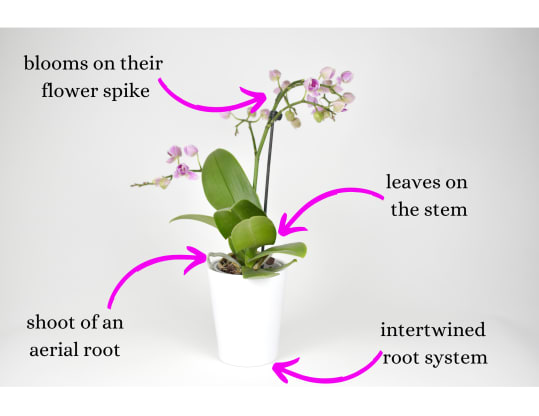As the parent of an orchid there comes a time when you need to give your plant some space – it has outgrown its original pot. Repotting is something that can seem daunting to new plant owners but it is actually pretty simple. Below is a guide to seamlessly transitioning your tropical beauty into a more comfortable space.
Orchid Anatomy
Here are some basics, it’s important to know what you’re working with!
When to Repot?
Once your orchid loses its flowers the first time it’s best to remove any moss it was planted with and repot. After your initial repotting you will need to size up the pot about every 1-2 years. Inspect your plant every spring (before it blooms) when the orchid is coming out of its dormant period. Some signs you need to repot include:
·New white roots poking out of the pot
·Broken-down potting medium (the chunky-woody soil) is no longer large and airy but dense and moist
·Tightly tangled roots – overlapping and interweaving roots are normal, but a tight ball-like tangle is not healthy
If it seems like you need to be a horticulturalist to inspect your orchids don’t worry, as long as you regularly repot and provide the right environment and water your plant will be healthy. The repotting process is pretty straightforward!
How Do I Choose a New Pot?
The rule of thumb is to choose a pot that has a diameter 1”-2” larger than the one before. Choose a pot with drainage so your orchid doesn’t sit in water. There are specialized orchid pots that add additional airflow to the roots which is nice but isn’t necessary. Pots are readily available online, at big box stores with a garden section and at your local ceramics studio!
What Do I Need?
·Fresh bark mix, available in garden centers and online
·Pruning shears or a sharp pruning knife
·Scissors or a razor blade
·Gloves if you like
·Pot or large bowl of water to soak the roots
·A fairly large surface you don’t mind getting messy
Your shears and ANY blade that will cut the plant need to be thoroughly cleaned, sterilized if possible. Orchids are very susceptible to infection. Their reputation as the divas of the houseplant world is earned in this regard!
How to Repot
Remove any damaged or yellowed leaves at their base with a sharp blade as close to the stem as possible. Remove your orchid from its pot. They can be very stuck so try “massaging” around the container to loosen the roots. Hold the orchid gently and try to pull the pot off of the plant, only pull very gently at the base of the stem (the thickest part right underneath the bottom leaves) if it won’t come out.
Care for the Roots
Once you have your orchid free from its previous home you will need to tend to its roots. Start by soaking them in cool or room temperature water for a few minutes, this will loosen them up and make them easier to untangle. Gently remove any soil or moss that may remain trapped in the roots with your hands and, using the sharp shears or blade, trim away any black, hollow or soggy roots. Give the roots a rinse.
Settle the Orchid in its New Home
Gently place your freshly manicured roots into the new pot, using your other hand to lightly pack the bark mix around them. Hold the plant so the base is an inch or two below the sides of the pot and add more mix to cover the top-most roots. Secure your leaves and, if you have them, flower spikes, with a dowel rod or by adjusting the position of the bark pieces
Tips:
·The stem of an orchid is the part that the leaves grow from. The shoots that produce the plant’s beautiful flowers are called “flower spikes”. It’s normal for flower spikes to wither and come off after your orchid’s blooms have all fallen off. You can trim these off at the base located underneath the leaves and new spikes will grow up the following growing cycle.
·It is worth it to invest in quality tools. Gardening shears are a must for this process and they will come in handy every time you need to care for a fresh flower bouquet. They are available online or in big box stores for under $10-$15 and will last years and years if they are stored dry, clean and sterilized before use.
·Are roots poking out of the top of the soil? Orchids produce aerial roots to collect moisture from the air and they even photosynthesize, just like the leaves. Do not cut these they nourish the plant and cutting healthy roots exposes the plants to potential infections.
·There are two types of orchid bark mix available in most stores (Home Depot etc.), general “orchid mix” that works for all types of orchids or phalaenopsis mix which is, no surprise, specifically for phalaenopsis orchids. If you know you have a phalaenopsis (most orchids that are sold commercially) then go for the specialized mix, otherwise you’re good with the general one.



